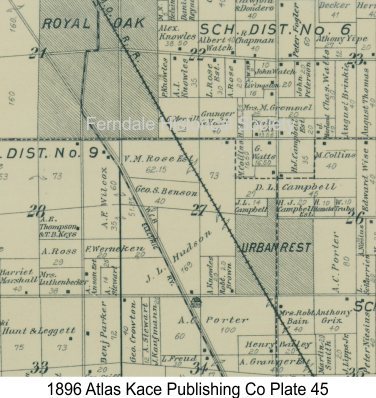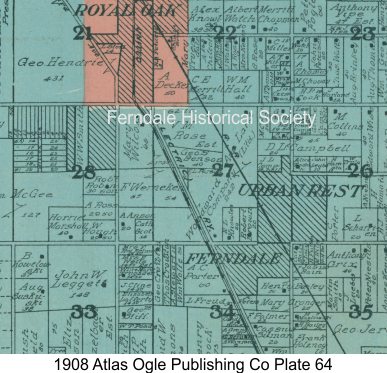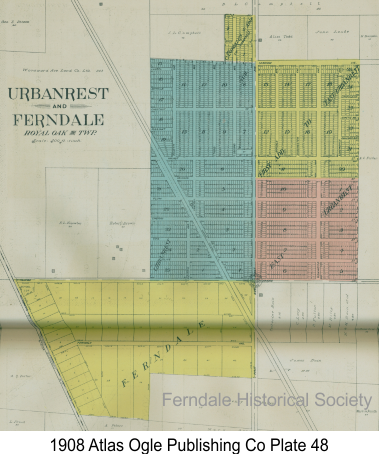HOW FERNDALE GOT ITS NAME
Lore says that a lineman stringing wires on a pole in the early 1900s is responsible for the name of the area now bordered by Detroit, Hazel Park, Oak Park, and Pleasant Ridge: He looked down and seeing the wide expanse of ferns beneath him, wrote “fern dale” in his log book. We have yet to find any notes or newspaper confirmation, but that story has persisted for decades.
The first mention of Ferndale's name in a newspaper was in a Royal Oak Tribune article on June 12, 1908 as follows:
"Because Royal Oak is dry is no reason why we can not have snakes and real ones too. Lawrence Croton, Elmer Knowles and William Benton have all seen and tried to kill a blue racer which has been making himself at home around and near the 9 mile road known as Ferndale, but have not succeeded as yet. This snake when first seen was only about 7 feet long but up to date has grown to be 9 feet long and if it lives 2 weeks longer will be 20 feet long. A mate to this snake was killed on Elmer Knowles farm about a year ago and measured 6 feet long."
Maurice Cole noted this finding in his 1971 book and shared it at the city's 50th Birthday celebration as shown below. We have yet to find an earlier mention of "Ferndale" in print - but continue to look!

FERNDALE APPEARS ON MAP
The earliest atlas found showing Ferndale Michigan is the 1908 Geo. A. Ogle Standard Atlas of Oakland County Michigan. Maurice Cole noted:
"The Oakland County Atlas, published about 1896,
showed only two communities within the township of
Royal Oak. These were Royal Oak and Urbanrest. A dozen years later the county atlas (1908) still shows Urbanrest as a separate community, but also adds, for the first time, a new name, Ferndale."
Note: On page 44 of his book, Mr. Cole listed the date as 1905. We believe this was a typo and he was still referring to the 1908 Atlas. We have not found any area atlas published in 1905.
Below are the two maps noted by Mr. Cole. The 1896 map has no mention of "Ferndale". However a familiar name owns a large swath of what would become Ferndale, that name is J.L. Hudson.



TALE OF TWO (POTENTIAL) CITIES
The 1912 History of Oakland County by T. Seeley noted the two communities as follows:
"Urbanrest and Ferndale - About a mile southeast of the village
limits of Royal Oak are two pretty
suburbs, or summer resorts, by these
names. The former lies partly in the southeast quarter of section 27 and
partly in the southwest quarter of section
26, and adjoins Ferndale to the
southwest, which is in the northeast
quarter of section 34, on the Detroit
United Railway. Quite a collection of
pretty cottages has been built within
the past few years, the owners including several citizens from Detroit and Pontiac."
Noted historian Charles Fey describes the creation of Urbanrest as follows:
"Albert Campbell settled on a tract
of land received from his father and
followed farming until the property
was chosen by the Cincinnati Syndicate
for the site of their new summer
resort, in 1890. His former farm
was eighty acres in extent, and was
disposed of for $12,500, being purchased for the town site of Urbanrest, Northwest corner of East Nine Mile Road and Campbell Roads."
Urbanrest was intended to become an incorporated
village when it was created in 1890, but that was never to happen, A story in the August 22, 1890 Pontiac Gazette reported:
"The New Village in Oakland. Urbanrest, a newly platted
village two miles below Royal Oak, on the D.G.H.
& M., is about ten days old. The lots are being sold at a rapidity unparalleled in the history of Michigan, 600 lots being sold Monday at private sale. The sale
was continued Wednesday and Friday. It is already a
flag station with trains from Detroit during the sale.
Andrew Campbell, who owns the 80 east of the plat sold the same on Tuesday for $ 15,000. It is a big boom in real estate."
The museum has several advertisements and additional information about Urbanrest for those interested. While the inexpensive country lots were snapped up quickly, many were later lost to tax foreclosure when owners were surprised to discover that they owed annual tax on their new property!
FERNDALE BECOMES A VILLAGE
The Sept 18, 1914 Royal Oak Tribune reported that:
"The people in the locality at the 9-mile road and Woodward avenue are enthusiastic over the prospects that the future holds out for them in a material way. They believe that community is going to grow and have taken steps to incorporate. A meeting was held at the Ferndale school house Tuesday evening and the matter was considered. A committee was appointed to take a census of the proposed village district and learn the sentiment relative to incorporating. The committee will report after two weeks, Sept 29."
We have not yet found a report, but excitement about incorporating as a village was in the air as noted in the news clipping below.

In 1917, residents of the many subdivisions inspired by growing streets like Pinecrest, Woodward, and Nine Mile voted to establish a village. The first president of the Ferndale City Commission, Lovell Turnbull, who also admired the ferns characteristic of the area, officially designated “Ferndale” as the new village's name.
On Monday Dec 10th, 1917 an election was held as reported in the Dec 14, 1917 Tribune:
"At the election at Ferndale Monday which was on the question of incorporating the territory at the nine mile road as a village, 113 voles favored incorporating and 13 votes opposed it. Elbert J. Chase. Gordon A. Damon. George H. Hall, Otis G. Morse and Lovell G. Turnbull were elected members of the committee to prepare the new charter for the village."
The real work of starting a village had begun. Minutes are on file at the museum for 1917 & 1918 that detail the work needed to prepare a charter to be voted upon.
On Monday April 1, 1918 a vote was held and reported by the Tribune on Friday April 5, 1918 as follows:
"The people of Ferndale village adopted their charter at the election Monday with only 10 votes in the negative. 155 votes were cast. L. G. Turnbull was chosen for president. John C. Graves for clerk, and Gordon A. Damon, G. Harold Leever, J. M. Hendershot and Geo. H. Hall for commissioners."
Ferndale was now a village! Most of the resident's concerns related to roads, ditches, & sewers, necessitating the quick formation of a Department of Public Works and resulting in political upheaval. Read more about that HERE.
THE CITY OF FERNDALE WAS FORMED
The details necessary to create a city are extensive and on file in hundreds of Village records. By December 1926 a proposed charter and slate of candidates was available to be voted upon. On April 4, 1927 an election was held and certified to make Ferndale a city. The details, as recorded in the 1927 city minutes, page 66, are as follows:
"We, the undersigned, who were appointed by the Charter Commission of the City of Ferndale, State of Michigan, to act as a Board of Canvassers to canvass the returns of the election held in said city on the 4th day of April, A.D. 1927, do hereby certify that we have canvassed the returns received from all the election precincts in said city for said election and that the following is a true and correct statement of the result of said canvass upon the following proposition:
"Shall the proposed Charter for the City of Ferndale, drafted by the Charter Commission elected on the 21st day of December, 1926, be adopted?"
The total number of' ballots having a cross (X) in the square after the word. "Yes" and in favor of the adoption of said Charter was Fifteen Hundred Seventy-seven (1577).
The total number of ballots having a cross (X) 1n the square after the word "No" and against the adoption of said Charter was Two Hundred Eighty-four (284).
We do therefore certify that the Charter drafted by the Charter Commission of the City of Ferndale, elected on the 21st day of December, 1926, was adopted by the electors of the City or Ferndale, State of Michigan, at said election held on Monday the 4th day of April, 1927.
IN WITNESS WHEREOF, we have hereunto set our hands this 4th day of April 1927.
(SIGNED) David Pence, Milton L. Kantz, Carl F. Newton
On motion duly made and carried, the canvassing board then adjourned."
Ferndale was now a city!
![]()





